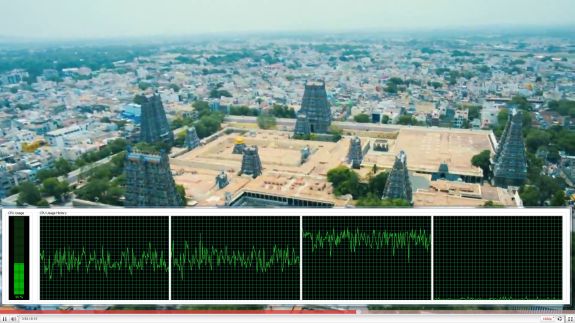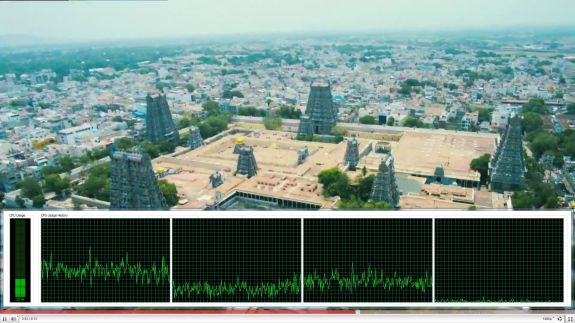ASRock Core 100HT-BD : Bringing HTPCs to the Mainstream Market [UPDATED : Noise Issue]
by Ganesh T S on July 19, 2010 9:34 PM EST- Posted in
- Home Theater
- Arrandale
- ASRock
- Media Streamer
- Core i3
- HTPC
The Core 100 HT-BD is well off from the networking perspective. It really doesn't matter if the unit is within reach of a wired network or not. We carried out all our tests with a 150 Mbps Draft-N wireless network. Despite being unable to utilize the maximum transfer rates available on the Core 100 HT-BD, we were easily able to stream HD clips of more than 50 Mbps. HD YouTube videos and HD Netflix streaming had no issues.
While on the topic of network streaming, let us take a brief look at how the system performs while accessing online video services. The first set of screenshots below show the CPU usage while playing back a 1080p YouTube video with and without hardware acceleration enabled. As can be seen, the GPU indeed supports Flash acceleration. Enabling hardware acceleration almost halved the CPU usage. Dedicated GPUs from ATI and Nvidia might result in lesser CPU usage. However, one is not really upset at having just 20% CPU utilization for a 1080p HD video. We expect similar results for videos on Hulu.
Netflix streaming, on the other hand, uses Microsoft's Silverlight technology. Unlike Flash, hardware acceleration for the video decode process is not controlled by the user. It is upto the server side code to attempt GPU acceleration. Thankfully, Netflix does try to take advantage of the GPU's capabilities. This is evident from the A/V stats recorded while streaming a Netflix HD video at the maximum possible bitrate of 3.8 Mbps. While the video is definitely not 1080p, we observe that the CPU utilization of around 30% is higher than the CPU usage for a 1080p YouTube video.
We suspect that the handling of the DRM in the case of Netflix streaming is done by the CPU, resulting in the higher usage. In any case, 30% CPU utilization for streaming the highest bit rate Netflix videos is not bad.
Users of media streamers streaming online videos often have to put up with messages of the sort 'This content is not available on TV connected devices' or need to queue up the videos on a PC before accessing them through their media streamer box. HTPC users don't need to worry about any such limitations. On the whole, the Core 100 HT-BD is a big winner from the network streaming standpoint.













107 Comments
View All Comments
ganeshts - Thursday, July 29, 2010 - link
Decaff,I will do more research on how to perfect the picture quality testing metrics.
For your second point, we do have a HTPC software article coming up (end of August) :)
Third, we just posted a review of the WDTV Live. Reviews of other boxes are coming up :)
BSalita - Saturday, July 31, 2010 - link
I congratulate Anandtech for holding out a comprehensive HTPC suite to quantify the performance of new gear. The industry has been lax in creating a consensus of how to properly test HTPC gear. I hope other review sites will likewise use this kind of test suite. Let the media server wanabees know what their systems must do to find a minimal level of acceptability. Only by holding out such a thorough test will we finally have the means for raising out of the quagmire of incomplete codecs, firmware and lightweight product comparisons.Hrel - Sunday, August 15, 2010 - link
1. No tv tuner2. No gaming
3. 700+ dollars?!
I agree with everyone else. I really see no appeal in this system. Something without a tv tuner and that doesn't function as a gaming system will never be worth more than 200, maybe 300 if the features were really nice.
I don't understand why people can't just use their laptops/desktops? I use my desktop on a 37" HDTV. Gaming, video encoding, internet browsing, torrenting, youtube, hulu, DVR, 2TB of storage internally in RAID!!!! Seriously, it's baffling why anyone would accept less when you simply don't have to.
vanderwijk - Monday, August 23, 2010 - link
I was very surprised to read that because HDMI port on the unit is 1.3a the maximum resolution is only 1920 x 1080. This would mean that my Dell 2408 would not be supported because its resolution is 1920 x 1200 :(A quick check on WikiPedia shows that HDMI 1.3a is capable of at least 1920 x 1200, so what's the deal here? Is this an error in the review or is it really not possible to display more than 1080 vertical pixels?
blacksun1234 - Wednesday, August 25, 2010 - link
Yes, it can support 1920x1200.blacksun1234 - Friday, September 3, 2010 - link
Dear Ganesh,Can it support BD 3D playback with Samsung 3D LED TV?
mega999 - Sunday, January 16, 2011 - link
Can it support BD 3D playback with Samsung 3D LED TV? -or do I need the new asrock visiond 3d one for that because of it's hdmi 1.4?Regards,
mega